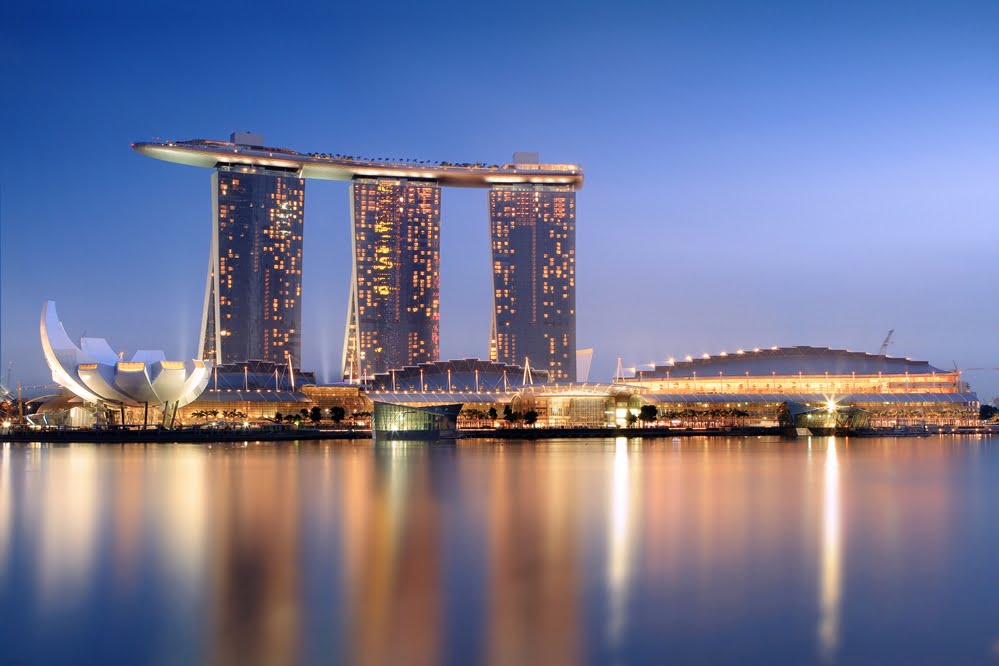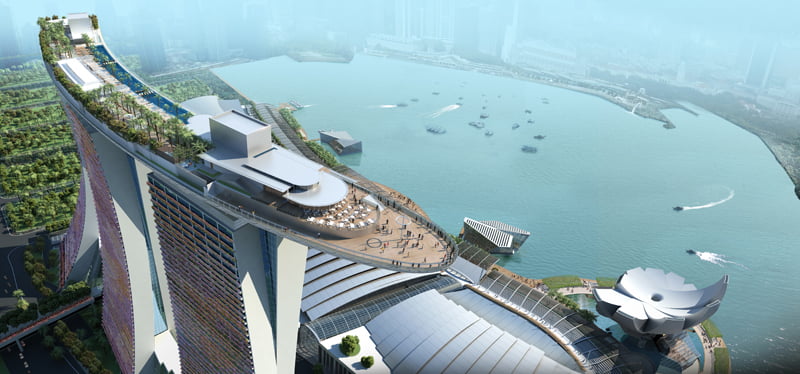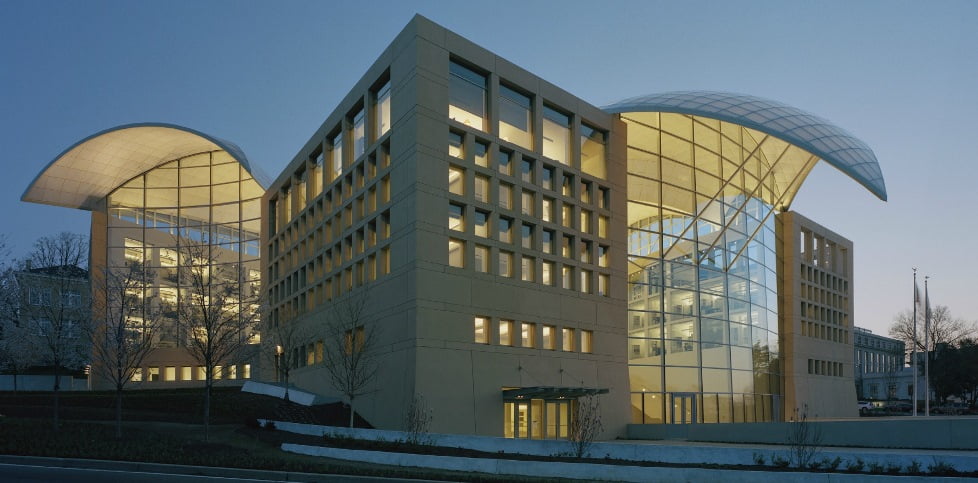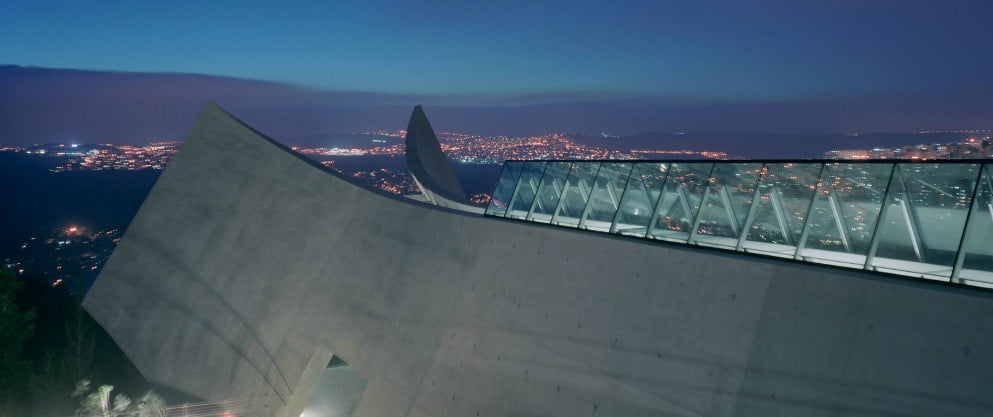Israeli-Canadian architect Moshe Safdie is a legendary name with breathtaking architectural projects under his belt that range from the famous Habitat 67 in Montreal, Canada, to the new Marina Bay Sands Hotel in Singapore. Safdie is known for his culturally and socially sensitive designs that respond to human aspirations – regardless of the size of the project: while Safdie used small Lego blocks to design his famous Habitat 67 complex in Montreal, his ingenuity also lies in the structural sophistication of his mega-buildings.
The Architect, urban planner, educator, theorist and author, now aged 77, was recently awarded the most prestigious recognition in the field of architecture: the 2015 American Institute of Architects Gold Medal. The award was given to Safdie thanks to his 85 futuristic designs of public and cultural spaces in three continents. Specifically, the award recognized Safdie’s most recent work in Singapore – the $6 billion Marina Bay Sands Hotel, owned by American billionaire Sheldon Adelson’s Las Vegas Sands Corp. The hotel features one of the most magnificent tourist attractions in the city – an infinity pool built over the roofs of Singapore skyscrapers, along with a museum, theaters, and other entertainment venues. The colossal structure with 56 floors, which dominates the skyline, is reminiscent of Stonehenge, the prehistoric monument located in Wiltshire, England.
In Safdie’s written nomination for the award, President of the Boston Society of Architects Emily Grandstaff-Rice noted that he “has continued to practice architecture in the purest and most complete sense of the word, without regard for fashion, with a hunger to follow ideals and ideas across the globe in his teaching, writing, practice and research.”
“Meaningful, vital, inclusive social spaces”
The Marina Bay Sands Hotel is not Safdie’s only project in Singapore. Safdie has recently launched his design for “Project Jewel” – a mixed-use addition to Singapore’s Airport. This megastructure dominates roughly 134,000 square meters. The facility features a glass dome with a thriving indoor garden and waterfall, in addition to shops, leisure and entertainment venues. The complex will be ready by 2018 for use by more than 53 million passengers per year.
But don’t be misled by the impressive scale of Safdie’s works; the foundation for all of Safdie’s projects is his spiritual design philosophy. “I try to make buildings humane. Countries and places have a history, a story, and a culture. I want my buildings to take root and look as if they’ve always been there,” he told Vanity Fair in 2012.
The goal of architecture, as stated on the Safdie Architects website, is that of creating “meaningful, vital, inclusive social spaces,” in addition to “mitigating the dehumanizing of the mega-scale,” as architecture caters to increasingly dense populations in urban centers.
SEE ALSO: Israeli Super Architect Moshe Safdie Designs Singapore Airport’s Incredible Bio-Dome
Critical acclaim at age 33
Safdie and his innovative approach to architecture was recognized internationally when his face was splashed on the cover of Newsweek at the age of 33. “The Shape of Things to Come” was the title of the Newsweek story, which portrayed the up-and-coming architect in 1971. That was four years after Safdie had designed his first solo project, the celebrated Habitat 67, as part of his master’s thesis at McGill University. The housing project was then built as a pavilion for the 1967 International and Universal Exposition in Montreal, Canada.
The futuristic residential complex of 158 stacked concrete units designed by the young aspiring architect earned him global acclaim. Habitat 67 redefined urban living by addressing high-density housing and improving social integration through architecture. In an interview for CBS in April 2014, Safdie described the story of his famed Habitat 67: “It was like a fairytale.”
Sign up for our free weekly newsletter
Subscribe
“Montreal – QC – Habitat67” by Wladyslaw – Own work. Licensed under CC BY-SA 3.0 via Wikimedia Commons.
Before the fairytale began, Safdie had lived in Haifa, Israel, where he was born in 1938. At age 15 he moved to Canada with his family, where he later attended McGill University, pursuing a degree in architecture. Before becoming a big name himself, Safdie apprenticed under the famed 20th-century architect Louis Kahn, who also was a recipient of the AIA Gold Medal. Following his apprenticeship with Kahn in the US, he returned to Montreal to oversee the master plan for the 67 World Expo. After establishing his own firm, Safdie opened a Jerusalem branch office in 1970, marking the beginning of his immense involvement in the rebuilding of Jerusalem.
Over the years, Safdie designed some of the most stunning buildings in Israel, including the David’s Citadel Hotel, Mamilla Promenade and IDF Square in Jerusalem. In 2004, he planned the airside building of terminal 3 in Ben Gurion Airport, which like its Singaporean counterpart also features a central waterfall surrounded by shops.
Following his work in Israel and in Canada, Safdie created a rich variety of projects, including cultural, educational and civic institutions, neighborhoods and parks, urban centers and airports, as well as master plans for new cities around the world. Some of his most acclaimed projects include the Yad Vashem Holocaust Museum in Jerusalem, the United States Institute of Peace Headquarters on the Mall in Washington D.C., and the Khalsa Heritage Memorial, a museum dedicated to India’s Sikh people. In addition to designing some remarkable monuments around the globe, Safdie has taught at Yale, McGill, and Ben Gurion Universities, as well as served as director of the Urban Design Program at Harvard University.
SEE ALSO: Israeli Architect Plans Green Paradise In China
Symbolizing life through structurally sophisticated monuments
In order to comprehend Safdie’s spiritual design, one must look closely at the Yad Vashem Holocaust Museum, which was built through a mountain. Safdie thought the story of the Holocaust was so horrific, that it could not be commemorated with an ordinary building. He wanted to reflect introspection, so he built underground. Safdie created a structure that takes you deep into the earth and then emerges at the other side of the mountain, a symbol that life has prevailed.
Safdie turns symbolism into structure. Most of his buildings are, as he has said, “drenched in light” because this reflects peace and transparency – hence the glass structure of the US Institute for Peace in Washington D.C. The facility is not only filled with light, but is also shaped to reflect the light of a dove.
At age 77, Safdie continues to infuse his projects with his philosophy and vision, whether they are in Canada, Singapore, Israel, or anywhere else in the world. Safdie, who typically shies away from the press, has said he uses light and water to achieve what rhythm and melody do in music. He has claimed that architecture has the same effect that music has on us, because it is beyond utility – it has to do with spirituality: “Every project, the sublime and the ordinary, has critical issues of humanity, of social responsibility.”
Photos, renderings and video: Wladyslaw, Someformofhuman (both via Wikimedia Commons), Las Vegas Sands Corp., Safdie Architects
Related posts

Rehabilitation Nation: Israeli Innovation On Road To Healing

Israeli High-Tech Sector 'Still Good' Despite Year Of War









Facebook comments